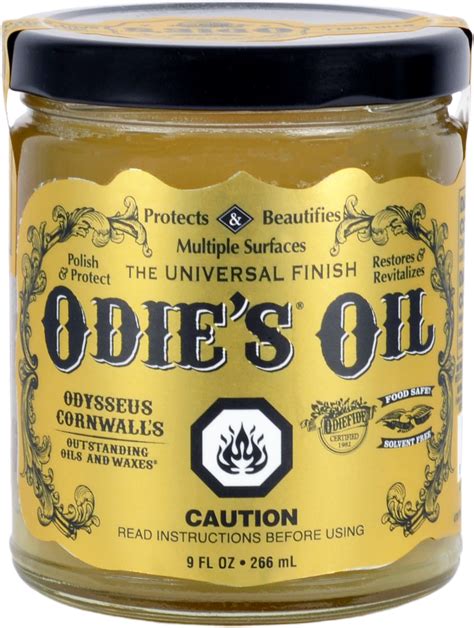Odie's Oil: The Secret to a Smooth, Even Finish
Odie's Oil isn't just another wood finish; it's a testament to the power of natural ingredients and meticulous craftsmanship. For years, woodworkers and furniture enthusiasts have whispered about its ability to deliver a flawlessly smooth, even finish that enhances the natural beauty of the wood. But what exactly makes Odie's Oil so special? This article delves into the unique properties of this remarkable product, exploring its application, benefits, and why it stands apart in the world of wood finishing.
What is Odie's Oil?
Odie's Oil is a penetrating oil finish formulated with a blend of carefully selected natural oils and resins. The precise recipe remains a closely guarded secret, but its effectiveness speaks for itself. Unlike surface coatings like varnish or lacquer, Odie's Oil soaks deep into the wood's pores, nourishing and protecting it from within. This deep penetration results in a durable, water-resistant finish that enhances the wood's natural grain and color.
The Benefits of Using Odie's Oil
The popularity of Odie's Oil stems from a multitude of benefits it offers over traditional wood finishes:
- Deep Penetration: This is arguably the most significant advantage. The oil penetrates deep into the wood, providing long-lasting protection against moisture and minor scratches.
- Enhanced Natural Beauty: Rather than masking the wood's natural grain, Odie's Oil accentuates it, bringing out the richness and depth of the color.
- Easy Application: Unlike some finishes that require multiple coats and meticulous sanding, Odie's Oil is relatively easy to apply, even for beginners.
- Durable Finish: The deep penetration and natural ingredients create a finish that is remarkably resistant to wear and tear.
- Water Resistance: While not completely waterproof, Odie's Oil provides significant protection against spills and moisture.
- Food Safe (When Properly Applied): Once cured, Odie's Oil is often considered safe for use on surfaces that come into contact with food, making it ideal for cutting boards and kitchen utensils. Always check the manufacturer's instructions to confirm food safety.
How to Apply Odie's Oil
Applying Odie's Oil correctly is key to achieving the desired results. While the exact instructions may vary slightly depending on the specific product, the general process is as follows:
- Prepare the Wood: Ensure the wood is clean, dry, and free from dust or debris. Lightly sand the surface to create a smooth base.
- Apply the Oil: Using a lint-free cloth, apply a thin, even coat of Odie's Oil, working with the grain of the wood.
- Allow to Penetrate: Let the oil sit for 15-20 minutes, allowing it to penetrate deep into the wood.
- Wipe Excess Oil: After the penetration time, use a clean cloth to wipe away any excess oil. Avoid leaving puddles or excess oil on the surface.
- Repeat: Depending on the wood type and desired level of protection, you may need to repeat steps 2-4. Multiple coats generally enhance durability and water resistance.
- Cure Time: Allow the final coat to cure completely according to the manufacturer's instructions. This typically involves several days or weeks of drying time.
Frequently Asked Questions (FAQ)
How long does Odie's Oil take to cure?
The curing time for Odie's Oil varies depending on the wood type, temperature, and humidity. Generally, it takes several days to a few weeks for the oil to fully cure. Always refer to the manufacturer's instructions for specific curing times.
Is Odie's Oil suitable for all types of wood?
While Odie's Oil works well on most hardwoods and softwoods, the absorption rate and final appearance may vary depending on the wood's porosity. It's always recommended to test the oil on a small, inconspicuous area first.
Can I use Odie's Oil on furniture that's already finished?
Applying Odie's Oil to previously finished furniture may yield unpredictable results. It's generally recommended to remove the existing finish before applying Odie's Oil to ensure proper penetration and a consistent finish.
How often should I reapply Odie's Oil?
The frequency of reapplication depends on the use and exposure of the finished piece. In high-traffic areas or areas exposed to moisture, more frequent applications may be necessary. Regular inspection will help determine when reapplication is needed.
Is Odie's Oil toxic?
Odie's Oil is typically formulated with natural oils and resins, but it's essential to always use proper ventilation when applying it and follow the manufacturer’s safety precautions. As with any wood finishing product, avoid contact with eyes and skin, and wash hands thoroughly after application.
By understanding the unique properties and application techniques of Odie's Oil, you can unlock its potential to create stunning, durable, and long-lasting wood finishes. The deep penetration, ease of use, and natural beauty it brings make it a favorite among woodworkers seeking a superior finish. Remember to always check the manufacturer’s instructions for specific details and safety guidelines.

